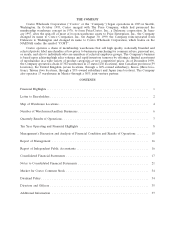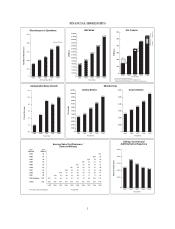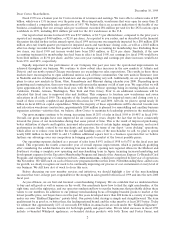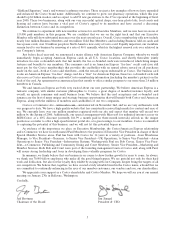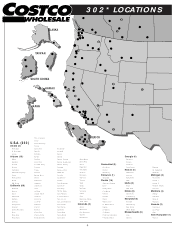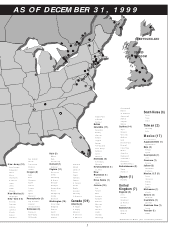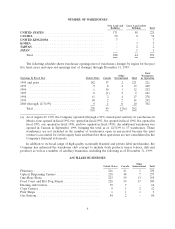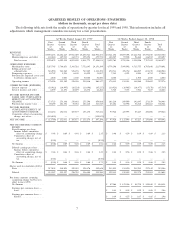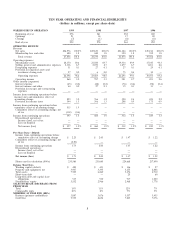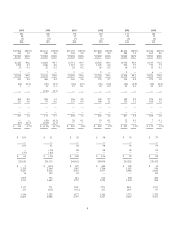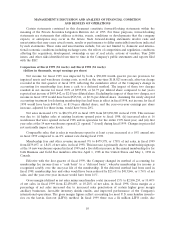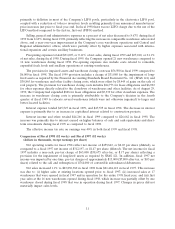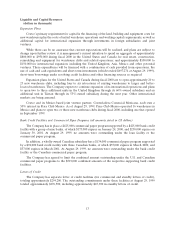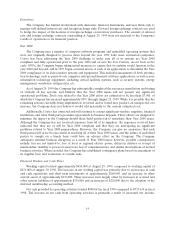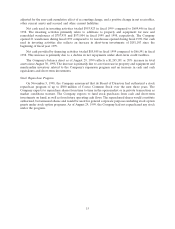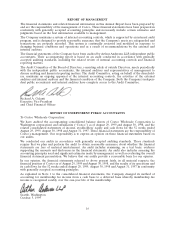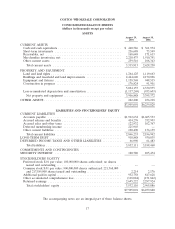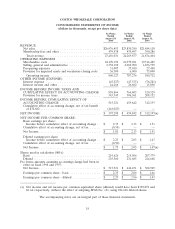Costco 1999 Annual Report Download - page 12
Download and view the complete annual report
Please find page 12 of the 1999 Costco annual report below. You can navigate through the pages in the report by either clicking on the pages listed below, or by using the keyword search tool below to find specific information within the annual report.MANAGEMENT’S DISCUSSION AND ANALYSIS OF FINANCIAL CONDITION
AND RESULTS OF OPERATIONS
Certain statements contained in this document constitute forward-looking statements within the
meaning of the Private Securities Litigation Reform Act of 1995. For these purposes, forward-looking
statements are statements that address activities, events, conditions or developments that the company
expects, or anticipates may occur in the future. Such forward-looking statements involve risks and
uncertainties that may cause actual events, results or performance to differ materially from those indicated
by such statements. These risks and uncertainties include, but are not limited to, domestic and interna-
tional economic conditions including exchange rates, the effects of competition and regulation, conditions
affecting the acquisition, development, ownership or use of real estate, actions of vendors, Year 2000
issues, and other risks identified from time to time in the Company’s public statements and reports filed
with the SEC.
Comparison of Fiscal 1999 (52 weeks) and Fiscal 1998 (52 weeks):
(dollars in thousands, except earnings per share)
Net income for fiscal 1999 was impacted by both a $50,000 fourth quarter pre-tax provision for
impaired assets and warehouse closing costs, as well as the one-time $118,023 non-cash, after-tax charge
recorded in the first quarter of fiscal 1999, reflecting the cumulative effect of the Company’s change in
accounting for membership fees from a cash to a deferred method. The impact of these two charges
resulted in net income for fiscal 1999 of $397,298, or $1.73 per diluted share compared to last year’s
reported net income of $459,842, or $2.03 per diluted share. Excluding the impact of these two charges, net
income in fiscal 1999 would have been $545,321, or $2.36 per diluted share. Assuming the newly adopted
accounting treatment for deferring membership fees had been in effect in fiscal 1998, net income for fiscal
1998 would have been $444,451, or $1.96 per diluted share; and the year-over-year earnings per share
increase, adjusted for these items, would have been 20%.
Net sales increased 13% to $26,976,453 in fiscal 1999 from $23,830,380 in fiscal 1998. This increase
was due to: (i) higher sales at existing locations opened prior to fiscal 1998; (ii) increased sales at 16
warehouses that were opened in fiscal 1998 and in operation for the entire 1999 fiscal year; and (iii) first
year sales at the 14 new warehouses opened (21 opened, 7 closed) during fiscal 1999. Changes in prices did
not materially impact sales levels.
Comparable sales, that is sales in warehouses open for at least a year, increased at a 10% annual rate
in fiscal 1999 compared to an 8% annual rate during fiscal 1998.
Membership fees and other revenue increased 9% to $479,578, or 1.78% of net sales, in fiscal 1999
from $439,497, or 1.84% of net sales, in fiscal 1998. This increase is primarily due to membership sign-ups
at the 14 new warehouses opened in fiscal 1999 and a five dollar increase in the annual membership fee for
both Business and Gold Star members effective April 1, 1998 in the United States and May 1, 1998 in
Canada.
Effective with the first quarter of fiscal 1999, the Company changed its method of accounting for
membership fee income from a ‘‘cash basis’’ to a ‘‘deferred basis’’, whereby membership fee income is
recognized ratably over the one-year life of the membership. If the deferred method had been used in
fiscal 1998, membership fees and other would have been reduced by $25,651 to $413,846, or 1.74% of net
sales, and the year-over-year increase would have been 16%.
Gross margin (defined as net sales minus merchandise costs) increased 15% to $2,806,254, or 10.40%
of net sales, in fiscal 1999 from $2,450,689, or 10.28% of net sales, in fiscal 1998. Gross margin as a
percentage of net sales increased due to increased sales penetration of certain higher gross margin
ancillary businesses, favorable inventory shrink results, and improved performance of the Company’s
international operations. The gross margin figures reflect accounting for most U.S. merchandise invento-
ries on the last-in, first-out (LIFO) method. In fiscal 1999 there was a $4 million LIFO credit, due
10


